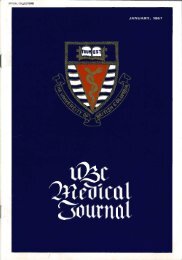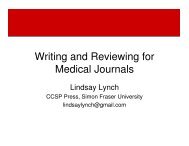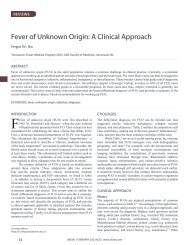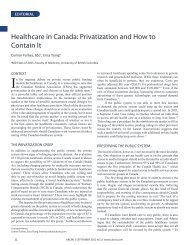Download full PDF - UBC Medical Journal
Download full PDF - UBC Medical Journal
Download full PDF - UBC Medical Journal
You also want an ePaper? Increase the reach of your titles
YUMPU automatically turns print PDFs into web optimized ePapers that Google loves.
YEAR 1<br />
Rpe65rd12/Rpe65rd12 C57BL6 mice.<br />
Methods: Yellow fluorescent protein (YFP)-labeled C2J ES cells<br />
were induced to differentiate into RPE-like structures on PA6<br />
feeders. RPE-specific markers are expressed from differentiated<br />
cells in vitro. After differentiation, ES cell-derived RPE-like cells<br />
were transplanted into the subretinal space of postnatal day 5<br />
Rpe65rd12/Rpe65rd12 mice. Live imaging of YFP-labeled C2J<br />
ES cells demonstrated survival of the graft. Electroretinograms<br />
(ERGs) were performed on transplanted mice to evaluate the<br />
functional outcome of transplantation.<br />
Results: RPE-like cells derived from ES cells sequentially<br />
express multiple RPE-specific markers. After transplantation,<br />
YFP-labeled cells can be tracked with live imaging for as long as<br />
7 months. Although more than half of the mice were complicated<br />
with retinal detachments or tumor development, one fourth of<br />
the mice showed increased electroretinogram responses in the<br />
transplanted eyes. Rpe65rd12/Rpe65rd12 mice transplanted<br />
with RPE-like cells showed significant visual recovery during a<br />
7-month period, whereas those injected with saline, PA6 feeders,<br />
or undifferentiated ES cells showed no rescue.<br />
Conclusions: ES cells can differentiate, morphologically, and<br />
functionally, into RPE-like cells. Based on these findings,<br />
differentiated ES cells have the potential for the development of<br />
new therapeutic approaches for RPE-specific diseases such as<br />
certain forms of retinitis pigmentosa and macular degeneration.<br />
Nevertheless, stringent control of retinal detachment and teratoma<br />
development will be necessary before initiation of treatment trials.<br />
Transplantation: POST AUTHOR CORRECTIONS, 15 February<br />
2010 doi:10.1097/TP.0b013e3181d45a61<br />
Safe Administration of Propofol in<br />
Children<br />
Maryam Dosani 1 , Jon McCormack 1 , Eleanor Reimer 1 ,<br />
Rollin Brant 2 , Guy Dumont 3 , Joanne Lim 1 , J. Mark<br />
Ansermino 1<br />
1<br />
Department of Anesthesiology, Pharmacology & Therapeutics,<br />
University of British Columbia<br />
2<br />
Department of Statistics, University of British Columbia<br />
3<br />
Department of Electrical and Computer Engineering, University<br />
of British Columbia<br />
Introduction: Propofol is increasingly used in children. Its use<br />
in some settings remains controversial as respiratory depression<br />
is a significant risk (1). Slower administration of propofol will<br />
reduce the drug’s peak concentration and may allow for the<br />
accumulation of carbon dioxide to offset central respiratory<br />
depression. This investigation aimed to increase the safety of<br />
propofol administration by developing a dosing schedule that<br />
would preserve spontaneous ventilation in at least 95% of subjects.<br />
Methods: With REB approval and informed consent, we<br />
recruited 52 ASA 1 & 2 children aged 6-15 years presenting for<br />
upper or lower gastrointestinal endoscopy in the operating room.<br />
An intravenous loading dose (LD) of propofol (4 mg/kg) was<br />
administered at a rate determined by a randomization schedule.<br />
Following the LD, propofol was infused at a rate of 200 mcg/<br />
kg/min for 5 min, or until a period of apnea was observed. The<br />
randomization schedule began with an initial rate of 1000 mcg/kg/<br />
min. The rate was sequentially increased by 100 mcg/kg/min until<br />
apnea was observed in three subjects. If apnea occurred, the rate<br />
for the subsequent subject was decreased by an increment of 100<br />
mcg/kg/min. The next 33 subjects were randomized according to<br />
a Biased Coin Design principle (2): The time for infusion was<br />
increased by 20 s if apnea occurred, or decreased by 20 s 5% of<br />
the time if spontaneous ventilation was preserved. The maximum<br />
infusion rate that preserves spontaneous respiration was calculated<br />
using the pooled-adjacent-violators algorithm (PAVA) and bootstrap<br />
methods were used to compute 95% confidence limits.<br />
Results: The analysis included 50 subjects, mean (SD) age 11.4<br />
(2.5) years and weight 43.0 (14.9) kg. Infusion rates ranged<br />
from 1000 mcg/kg/min to 2300 mcg/kg/min. Seven subjects<br />
experienced apnea. The mean (SD) time to apnea was 104 (36) s<br />
and duration was 93 (51) s. A LD of propofol administered over<br />
3.0 min maintained spontaneous ventilation in 95% of subjects<br />
(CI= 1.9 - 3.5).<br />
Conclusion: A 4 mg/kg dose of propofol, administered as the sole<br />
anesthetic agent over 3 min, maintained spontaneous ventilation<br />
in 95% of subjects aged 6-15 years.<br />
Phosphoinositide 3-kinase p110delta<br />
regulates natural antibody production,<br />
marginal zone and B-1 B cell function,<br />
and autoantibody responses<br />
Caylib A. Durand 1 , Karsten Hartvigsen 2 , Linda<br />
Fogelstrand 2 , Shin Kim 1 , Sally Iritani 3 , Bart<br />
Vanhaesebroeck 4 , Joseph L. Witztum 2 , Kamal D. Puri 3 ,<br />
Michael R. Gold 1<br />
1<br />
Department of Microbiology and Immunology, I3 and CELL<br />
Research Groups, Life Sciences Institute, University of British<br />
Columbia<br />
2<br />
Department of Medicine, University of California at San Diego,<br />
La Jolla, USA<br />
3<br />
Calistoga Pharmaceuticals Inc., Seattle, WA, USA<br />
4<br />
Centre for Cell Signalling, Institute of Cancer, Barts and The<br />
London School of Medicine and Dentistry, Queen Mary<br />
University of London, London, UK<br />
B-1 and marginal zone (MZ) B cells produce natural antibodies,<br />
make antibody responses to microbial pathogens, and contribute to<br />
autoimmunity. Although the delta isoform of the phosphoinositide<br />
3-kinase p110 catalytic subunit is essential for development of<br />
these innate-like B cells, its role in the localization, activation,<br />
and function of normal B-1 and MZ B cells is not known. Using<br />
IC87114, a highly selective inhibitor of p110delta enzymatic<br />
activity, we show that p110delta is important for murine B-1<br />
and MZ B cells to respond to B cell receptor (BCR) clustering,<br />
the Toll-like receptor (TLR) ligands LPS and CpG DNA, and<br />
the chemoattractants CXCL13 and sphingosine 1-phosphate. In<br />
these innate-like B cells, p110delta activity mediates BCR-, TLRand<br />
chemoattractant-induced activation of the Akt pro-survival<br />
<strong>UBC</strong>MJ | APRIL 2010 1(2) | www.ubcmj.com 2










